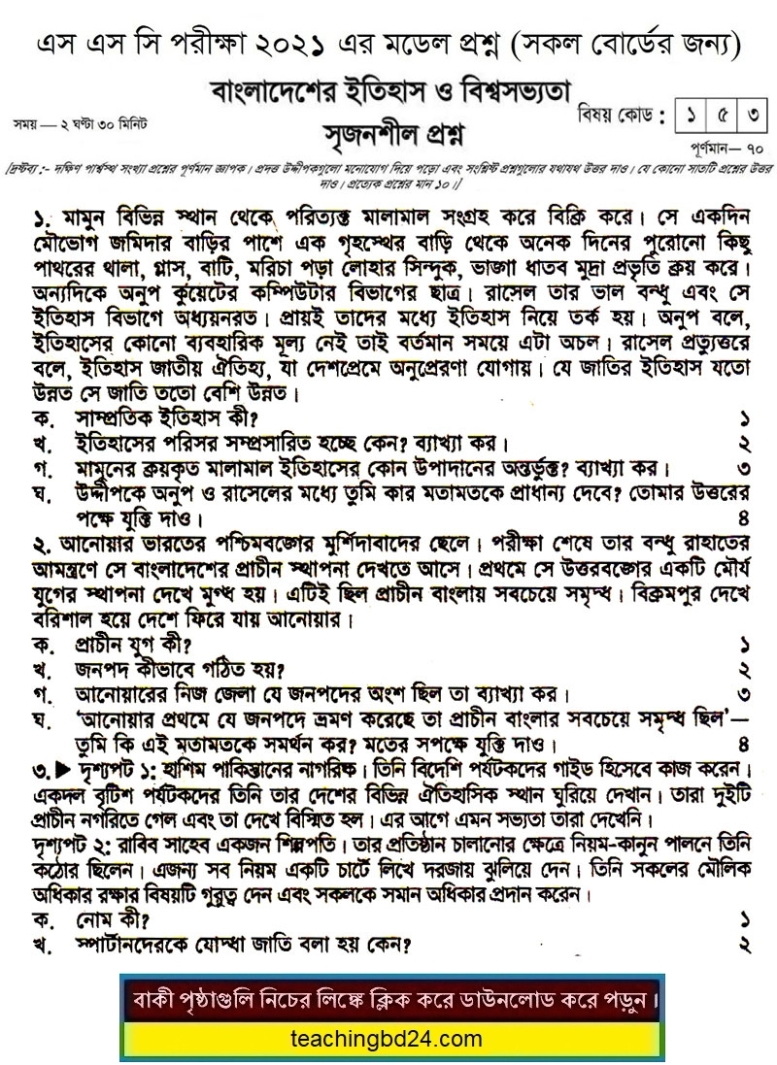SSC History of Bangladesh and World Civilization Suggestion Question 2021-3. The Liberation War of Bangladesh took place in 1971. Our country became free from the enemies on 16 December after a nine-month staunch war against the Pakistani army. The Liberation war is the story of our glory and pride. The Bangalees have such many events of glory. History represents events. It provides the sequential and true account of what has been clearly described in it. In order to conduct a comprehensive investigation of history, it is necessary to become informed of the elements and classification of history. In this chapter, we will know how we should study history.
SSC History of Bangladesh and World Civilization Suggestion Question 2021-3

Model Question No. 3

Before that, we need to know what history is? We also need to know how many types of history are there or how to write history. What is the usefulness of studying history? In this present chapter, there will be a discussion about these topics.
The riverine country of Bangladesh (“Land of the Bengals”) is one of the most densely populated countries in the world, and its people are predominantly Muslim. As the eastern portion of the historical region of Bengal, the area once formed, along with what is now the Indian state of West Bengal, the province of Bengal in British India. With the partition of India in 1947, it became the Pakistani province of East Bengal (later renamed East Pakistan), one of five provinces of Pakistan, separated from the other four by 1,100 miles (1,800 km) of Indian territory. In 1971 it became the independent country of Bangladesh, with its capital at Dhaka.
Bangladesh is bordered by the Indian states of West Bengal to the west and north, Assam to the north, Meghalaya to the north and northeast, and Tripura and Mizoram to the east. To the southeast, it shares a boundary with Myanmar (Burma). The southern part of Bangladesh opens into the Bay of Bengal.
Stretching northward from the Bay of Bengal, Bangladesh constitutes roughly the eastern two-thirds of the deltaic plain of the Padma (Ganges [Ganga]) and Jamuna (Brahmaputra) rivers. Except for small higher areas of jungle-covered old alluvium (rising to about 100 feet [30 meters]) in the northwest and north-center—in the Barind and the Madhupur Tract, respectively—the plain is a flat surface of recent alluvium, having a gentle slope and an elevation of generally less than 30 feet (9 meters) above sea level.
In the northeast and southeast—in the Sylhet and Chittagong Hills areas, respectively—the alluvial plains give place to ridges, running mainly north-south, that form part of the mountains that separate Bangladesh from Myanmar and India. In its southern region, Bangladesh is fringed by the Sundarbans, a huge expanse of marshy deltaic forest.
Bangladesh, in general, possesses luxuriant vegetation, with villages appearing to be buried in groves of mango, jackfruit, bamboo, betel nut, coconut, and date palm. However, only a small portion of the country’s land surface is covered with forests.
teachingbd24.com is such a website where you will get all kinds of necessary information regarding educational notes, suggestions and question patterns of schools, colleges, and madrasas. Particularly, you will get here special notes of physics that will be immensely useful to both students and teachers. The builder of the website is Mr. Md. Shah Jamal Who has been serving for 35 years as an Assistant Professor of Physics at BAF Shaheen College Dhaka. He expects that this website will meet up all the needs of Bengali version learners /students. He has requested concerned students and teachers to spread this website home and abroad.
Discover more from Teaching BD
Subscribe to get the latest posts sent to your email.


